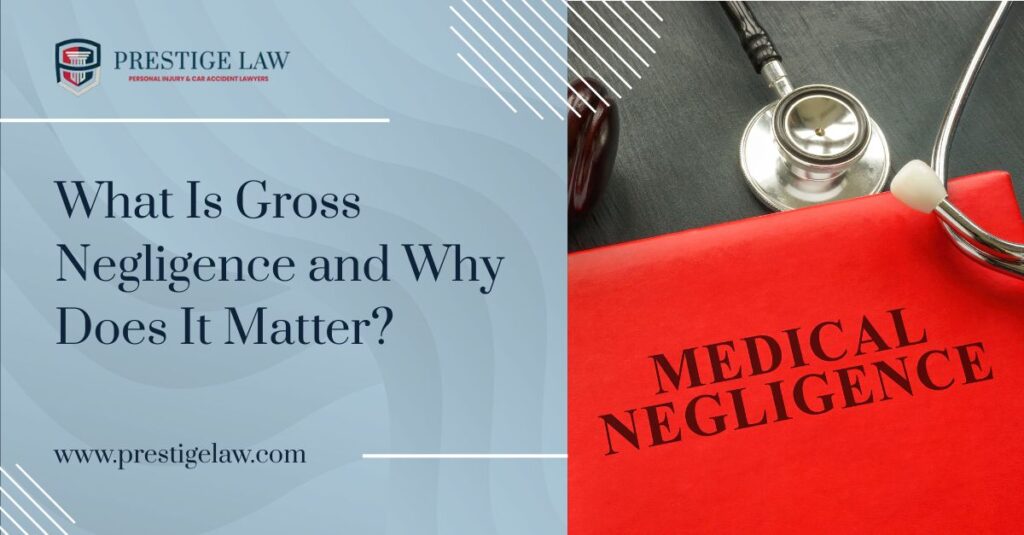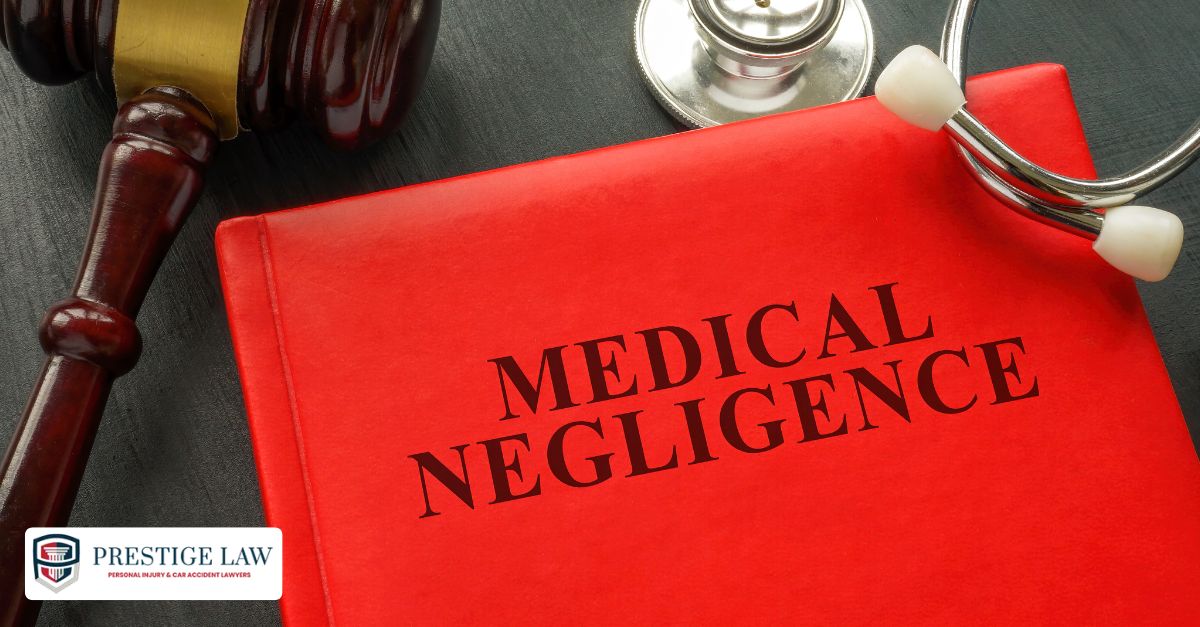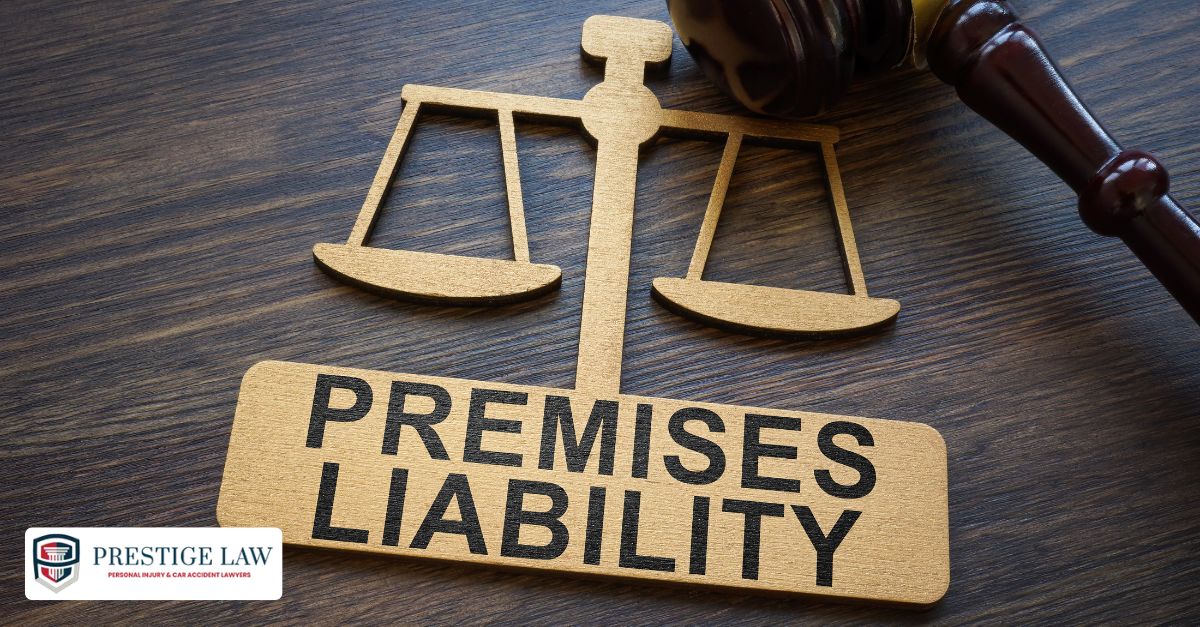
California Law on Gross Negligence in Injury Cases
Published on / Category: Car Accidents, Catastrophic Injuries, Insurance Claims, Personal Injuries, Work Injuries
Your brakes fail. The truck behind you doesn’t stop. You’re in the hospital, and someone says the word “accident.” But was it?
Let’s be honest; not every mistake is innocent. Some are reckless. Some are avoidable. Some cross the line.
That line is called gross negligence.
If you’ve been injured—or accused—you need to know where that line is, what happens when it’s crossed, and why it matters.
In California, the difference between ordinary negligence and gross negligence isn’t just legal jargon. It can shape the outcome of your case—determining whether you receive full compensation or get left with the bill.

What Most People Get Wrong About Negligence
Most people hear the word “negligence” and think of a simple mistake—a moment of carelessness. Someone forgot something, slipped up, or wasn’t paying attention. But that’s only part of the story.
In personal injury law, negligence means failing to take reasonable care. It’s about a duty someone had—and how far they fell short of meeting it. It’s not just about what happened, but whether it was preventable if proper care had been taken.
Now imagine something more serious: a situation where the risk wasn’t just missed—it was ignored. Where someone knew their actions were dangerous but moved forward anyway.
That’s not carelessness. That’s a conscious disregard for safety. That’s gross negligence.
The Legal System Draws a Line — You Should Too
The courts in California don’t lump all forms of carelessness into one category—and neither should you.
Ordinary negligence and gross negligence are two separate legal standards, and the difference between them can drastically change the outcome of a case.
When gross negligence is established, it unlocks legal tools that can significantly increase what a victim may recover:
- Higher damages
- Potential for punitive awards
- More pressure on insurance carriers to settle
Drawing that legal distinction is essential. Whether you’re filing a claim or defending against one, recognizing where that line is—and proving which side of it applies—is critical.
Let’s break it down side by side: here’s how ordinary negligence compares to gross negligence, and why it matters in every serious personal injury case.
Ordinary Negligence Vs. Gross Negligence — What’s The Difference? |
||
|
Factor |
Ordinary Negligence |
Gross Negligence |
|
Mindset |
Careless or Inattentive |
Reckless Disregard or Conscious Indifference |
|
Duty Of Care |
Breached by Failing to Act Reasonably |
Breached by Ignoring Obvious, Serious Risks |
|
Intent |
Unintentional Mistake |
No Intent to Harm, But Clear Disregard for Consequences |
|
Examples |
Running a Red Light by Accident |
Driving 90 in a School Zone |
|
Legal Consequences |
Compensatory Damages (Medical Bills, Lost Wages) |
Compensatory + Possible Punitive Damages |
|
Insurance Coverage |
Typically Covered |
May Trigger Exclusions or Disputes |
|
Proof Required |
Show Failure to Meet Standard Care |
Show Reckless Pattern, Ignored Warnings, or Egregious Act |
|
Common Defenses |
Comparative Fault, No Duty |
Emergency Doctrine, Assumption of Risk |
If you’ve been injured, ask yourself: was it just a slip-up—or something more serious?
That answer could shape the value of your claim. And if you’re the one being accused, the ability to show that line was not crossed could be the difference between a fair resolution and a financial disaster.
What is gross negligence?
Gross negligence isn’t about being more careless—it’s about being reckless.
In legal terms, it marks a threshold. In California, gross negligence refers to a conscious disregard for known risks. It means someone didn’t just fail to act—they chose not to.
That distinction matters.
Why? Because when gross negligence is proven, it changes the stakes:
- Punitive damages become possible.
- Insurance coverage may be denied or challenged.
- Personal liability exposure increases dramatically.
This isn’t just a matter of how someone got hurt—it’s a question of how much the responsible party knew and ignored. When gross negligence enters the equation, it reframes the entire case—and gives it legal weight that standard negligence does not.
Gross Negligence Creates Legal Leverage
Ordinary negligence may justify compensation. But gross negligence? That’s legal leverage.
When the conduct is so reckless it shocks the conscience—especially in catastrophic injury cases—everything changes. It’s no longer just about recovering costs. It’s about accountability.
At Prestige Law Firm, we’ve seen this firsthand. In motorcycle accidents, employer site failures, and high-speed crashes, identifying gross negligence early shapes the entire strategy.
It tightens the defense. It puts pressure on insurers. It signals to the other side that this case may not settle quietly.
When framed correctly, gross negligence doesn’t just raise the stakes—it sets the tone.
Where Gross Negligence Shows Up in Injury Cases
Gross negligence isn’t rare. It’s often hidden behind terms like “accident” or “oversight.” But once you know where to look, patterns emerge.
Here’s where gross negligence often shows up—and why it matters:
Auto and Motorcycle Accidents
Some traffic collisions aren’t just unfortunate mistakes. They’re the result of choices that ignored obvious safety risks.
- A trucking company skipping required inspections
- A driver operating while drowsy or distracted
- A vehicle released with serious manufacturing defects
- A motorcyclist struck by someone speeding or weaving through traffic
These aren’t lapses in judgment—they’re patterns of reckless conduct.
If your injuries stemmed from this kind of behavior, understanding gross negligence in car accident cases is key to determining whether you’re entitled to more than basic compensation.
And when a motorcyclist is injured because another driver was intoxicated or ignored traffic laws, the legal implications of gross negligence in motorcycle accidents can significantly impact the outcome of the case.
Construction Sites
Job sites are high-risk environments. But when shortcuts replace safety, workers pay the price.
- Scaffolding without anchors
- Heavy machinery operated by untrained workers
- Supervisors ignoring repeated OSHA violations
That’s not “bad luck.” That’s gross negligence—and it can’t be dismissed as part of the job.

Premises Liability
People joke about slip and fall cases—until a loose handrail causes a spinal injury.
- A slick grocery aisle with no warning signs
- Months of ignored electrical issues in an apartment
- A hotel disabling smoke detectors to reduce guest complaints
These aren’t accidents. They’re avoidable hazards, left unaddressed for too long.
Medical and Professional Negligence
When you trust a professional, the stakes are higher. And when that trust is broken?
- A doctor ignoring abnormal test results
- A daycare leaving kids unsupervised near hazards
- A therapist dismissing escalating warning signs
These failures aren’t system glitches. They’re conscious decisions to look away—qualifying as gross negligence under California law.
Stop Proving Accidents — Start Proving Indifference
Most people still view accidents as if they’re flukes. “It just happened.” “No one meant for it to go wrong.” But if you want to win a case involving gross negligence, that mindset will cost you.
The fault is about what was done wrong.
Gross negligence is about what was ignored despite the risk.
That’s the shift from outcome to exposure. What risks were obvious? What warnings were missed? What protocols were in place, and why were they bypassed?
Gross Negligence Is a Pattern — Not a Moment
One reckless act isn’t enough. Gross negligence is rarely about a single failure. It’s about a series of decisions that created danger over time.
- The equipment wasn’t just defective—it had a repair history.
- The driver wasn’t just tired—he had a prior violation on file.
- The property wasn’t just unsafe—it had been reported and ignored.
That’s how gross negligence is proven: by showing that someone had opportunities to fix a risk—and chose not to.
So when you’re building your case, don’t zero in on the final moment. Zoom out. Create the timeline. You’re not just documenting an incident. You’re exposing a pattern of neglect.
You’re Not Just Proving What Happened — You’re Proving What Was Ignored
In gross negligence cases, the defense will rarely say, “We knew the risk and ignored it.” More often, they’ll claim they didn’t know at all.
That’s where your strategy matters.
To prove gross negligence, you must show that they should have known—or that the risk was so obvious, ignorance isn’t a valid excuse.
That means pulling records. Inspection logs. Complaints. Emails. Maintenance reports. All the evidence that shows warnings were there—and ignored.
Gross negligence cases aren’t won by emotion. They’re won with patterns, documents, and pressure. The stronger the paper trail, the harder it is for the defense to hide behind the idea of an honest mistake.
Why It Matters to Your Case and Your Claim
The term “gross negligence” doesn’t just change how a case sounds—it changes what it’s worth.
When that phrase enters the conversation, punitive damages may be on the table. That signals something bigger than compensation: it signals accountability.
For injured plaintiffs, this shift can be critical:
- Settlement offers tend to rise
- Insurance carriers reassess their exposure
- Defendants often drop the posturing and start calculating risk
But if you’re the one being accused, the stakes can rise just as fast. It’s no longer about who pays for car repairs. It becomes about how a jury sees your actions—reckless, not just careless.
In either case, the presence of gross negligence fundamentally reshapes your legal strategy—and the outcome you can expect.
How It Impacts Strategy — Not Just Outcomes
Most personal injury cases follow a predictable rhythm: gather evidence, negotiate, and possibly litigate.
But when gross negligence is part of the case, that rhythm changes.
These cases create pressure early—especially when the defendant is a company with a public reputation or a record of repeat violations. The threat of punitive damages can do more than raise the payout. It can change how the entire case unfolds.
Here’s how:
- Insurance companies may push for early settlement to avoid trial risk
- Liability may be distributed differently among parties
- Jurors may become more sympathetic to the plaintiff
This is why your legal team needs to do more than prove harm. They must prove how the harm happened—and what was ignored.
Handled correctly, gross negligence becomes more than a legal standard. It becomes the backbone of your leverage.

Why the Right Lawyer Will Frame It Differently
Not every personal injury attorney understands how to handle a gross negligence case properly.
Some treat it like an emotional trigger—a dramatic label meant to pressure the other side. But when it’s used carelessly, it loses impact. Worse, it can weaken your credibility.
Framing gross negligence isn’t about flair. It’s about structure and strategy:
- Building a pattern—not just documenting the incident
- Showing a chain of decisions—not just a bad outcome
- Proving indifference—not just error
At Prestige Law Firm, that’s exactly what we do. We’ve handled catastrophic claims where the difference between ordinary and gross negligence meant the difference between walking away empty-handed—or securing a seven-figure result.
When the stakes are high, you need expert legal representation for gross negligence claims—from a team that knows how to build these cases from the ground up.
Legal Defenses in a Negligence Claim
When gross negligence is alleged, most defendants won’t claim they did everything perfectly. Instead, their strategy is usually to shift the blame—or blur the severity.
They aim to create doubt, reduce liability, and limit financial exposure.
Here are four common defenses they may raise, especially in California:
1. Comparative Fault
California follows a comparative negligence model. That means your compensation can be reduced if you’re found partly responsible for the incident.
Examples:
- You were speeding when someone else ran a red light
- You ignored a posted warning on a job site
Even a 10% fault assessment can affect a large settlement. That’s why controlling the narrative of who ignored what—and when—is just as important as the facts.
2. Assumption of Risk
If you knowingly entered a risky situation—like a dangerous job site, a high-contact sport, or signed a liability waiver—the defense may argue that you “assumed the risk.”
But here’s the limit: you can’t assume risks that were recklessly concealed.
For example, a repair shop that knowingly returns a car with faulty brakes creates a hidden danger. The customer didn’t accept that risk—they trusted the shop.
That’s why liability of body shops for gross negligence in vehicle repairs becomes a central issue in many injury cases.
3. No Duty Owed
Sometimes, the defense argues that they didn’t owe the plaintiff a legal duty.
Examples:
- A bystander had no legal obligation to intervene in an emergency
- A landlord denies control over the space where an injury occurred
If they succeed, the case may not survive the first motion. That’s why establishing duty clearly and early is non-negotiable.
4. Emergency Doctrine
In sudden, high-stress situations—like a fire or crash—the defense might claim they acted reasonably under emergency conditions.
This doctrine can protect split-second decisions made in good faith. But it doesn’t protect patterns of neglect leading up to that emergency.
Conclusion
Let’s call it what it is. When someone knowingly cuts corners and puts others at risk, it’s not just a mistake—it’s gross negligence.
Whether it’s a trucking company skipping safety checks, a body shop clearing a car with known defects, or a driver showing total disregard for others, California law treats those actions seriously—and so should you.
If you’ve been injured, this isn’t the time to stay quiet or settle quickly. The moment you frame the case as a reckless disregard for safety rather than an unfortunate mistake, you change the narrative—and strengthen your legal position.
At Prestige Law Firm, we don’t chase sympathy. We build pressure. We uncover patterns. And we provide comprehensive personal injury legal services that hold reckless parties accountable under California law.
📞 Call (818) 788-0808 or (661) 341-3939 to speak with a live agent 24/7
🌐 Visit prestigelaw.com to schedule your free consultation today.
FAQs
What constitutes gross negligence?
Gross negligence involves a reckless disregard for safety—more than carelessness, but short of intentional harm.
How is gross negligence proven in court?
It’s shown through patterns of ignored warnings, skipped protocols, or repeated safety violations supported by records or expert testimony.
Can you sue for gross negligence?
Yes. If gross negligence caused your injury, you can file a lawsuit and may qualify for punitive as well as compensatory damages.
What is the difference between gross negligence and willful misconduct?
Gross negligence is extreme carelessness. Willful misconduct involves knowingly causing harm or ignoring certain danger.
Does gross negligence lead to punitive damages?
It can. California law allows punitive damages when gross negligence shows a conscious disregard for others’ safety.
Get Started Today!
24 hours a day / 7 days a week / 365 days a year
Contact our Los Angeles attorneys for a free consultation today
